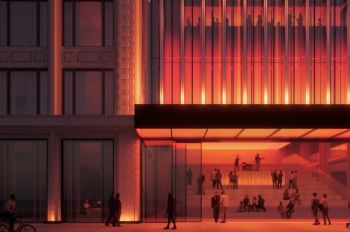Architecture Professor Receives Prestigious Institute for Advanced Study Fellowship

In Christopher Nolan’s 2023 movie Oppenheimer, a pivotal reoccurring scene shows renowned physicists and history-defining figures Albert Einstein and J. Robert Oppenheimer standing in a grassy field next to a pond. The scene takes place on the campus of the renowned Institute for Advanced Study (IAS) in Princeton, New Jersey. The Institute—where Einstein was a full-time faculty member for more than two decades and Oppenheimer was its longest-tenured director for 19 years—is now the temporary home of College of Architecture Associate Professor Sean Keller, a 2024–2025 member in the School of Historical Studies.
For Keller, exploring the campus has historic echoes.
“You definitely have a feeling that you’re at a place where there have been quite important people and ideas,” he says.
Every year, IAS welcomes more than 250 of the most promising postdoctoral researchers and distinguished scholars from around the world advance their research in an interdisciplinary and collaborative environment. Institute fellowships are awarded across four schools, representing both the sciences and humanities. Keller is one of only a handful of architectural historians in the program this year.
“I think it’s a strong endorsement from the outside of what I’ve been working on,” he says.
During his time as the Institute’s Agnes Gund and Daniel Shapiro Member, Keller will focus on completing a book about the architecture, landscapes, and art created for the 1972 Summer Olympics in Munich in collaboration with his co-author and spouse Christine Mehring, a professor of art history at the University of Chicago. With their shared interests in post-war architectural and art history, Keller and Mehring are looking to dig deeper into the technical, aesthetic, and political aspects of this significant work.
“West Germany was trying to display itself as an entirely new country,” says Keller. “The last time that Germany had hosted the Olympics was in 1936 when the National Socialists were in power, and Hitler used it as a showpiece. 1972 was really a very important opportunity for Germany to demonstrate to the world how it had changed. Of course, all of that was tragically disrupted by the infamous terrorist attack on the Israeli delegation. We’re interested in the material context of the games and the many tensions that already existed there before the attack overtook our understanding of this event.”
Keller explains that it took Germany about four years to build the new Olympic complex, which included sports venues, a large park, and housing that was used as the Olympic village. For the main athletic venues, architects Behnisch & Partner hoped to present a changed nation by avoiding all “traditional buildings.”
“Instead there is a large swooping, draping roof made from a steel cable net covered with plexiglass panels and fabric. It resembles a tent, and perhaps the nearby Alps. Nothing like it had ever been done at that scale, and the process of designing it led to major advances in physical and computational modeling. It also offered a new vocabulary for large-scale national architecture. It’s an anti-monumental, anti-nationalist national monument,” he says.
“From an academic’s point of view, the greatest advantage of the fellowship is simply the time to focus solely on one’s research,” says Keller. With around ten trips to Germany to pour through archives under his belt, he’s ready to finish the book, which will then be published by Yale University Press.




